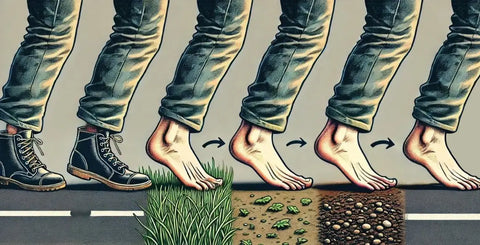Transitioning to barefoot shoes can significantly improve foot health and overall comfort while walking. However, it's essential to approach this process correctly to avoid discomfort and give your feet time to adapt. Here are some helpful tips on how to start wearing barefoot shoes.
1. Determine the Correct Size
One of the most important steps when transitioning to barefoot shoes is making sure you choose the right size of barefoot footwear. Unlike conventional shoes, barefoot footwear requires extra room for natural toe splay and movement. A snug fit may feel familiar, but it can restrict foot function and comfort.
Before buying, make sure to check out our Size Measuring Guide - it will walk you through how to measure your feet accurately at home and find your ideal fit.
Wondering why barefoot shoes shouldn’t fit like traditional ones? Read our article "Why Barefoot Shoes Need Extra Space" to understand how proper toe room supports healthy movement, stability, and muscle activation.
2. Gradual Transition
If you're used to wearing conventional shoes with rigid soles and arch support, it's crucial to transition to barefoot shoes gradually. Start with short walks in barefoot shoes and gradually increase the wearing time. Your foot muscles and ankle muscles need time to adjust to the new conditions to avoid fatigue and potential discomfort.

3. Choose the Right Surface
At the beginning, wear your barefoot shoes on flat and soft surfaces, such as grass or sand. This will help minimize stress on your feet as they adapt to the new conditions. As your foot muscles strengthen, you can transition to harder surfaces, like asphalt or concrete.
4. Pay Attention to Your Walking Technique
Barefoot shoes promote a more natural walking technique, which involves landing on the forefoot or midfoot rather than the heel. Pay attention to your movements: try to walk smoothly, avoiding hard impacts. This will help reduce stress on your joints and ligaments.
5. Start with Minimalist Shoes
If the switch to fully barefoot shoes feels too abrupt, start with minimalist shoes. These shoes have a thin sole, flexible design and minimal cushioning but still offer some support. This is an excellent step before fully transitioning to barefoot shoes.
If you're just getting started, take a look at our collection for beginners - an easy way to ease into the barefoot lifestyle with supportive, stylish options.
6. Listen to Your Body
Pay attention to your body and don’t rush the adaptation to barefoot shoes. If you feel fatigue or discomfort in your feet, reduce the time spent wearing barefoot shoes and give your feet a chance to rest. Over time, your muscles will strengthen, and you'll be able to wear barefoot shoes without limitations.
Transitioning to barefoot shoes is a gradual process, but one that can improve your foot health, posture, and overall comfort. Follow these steps and enjoy the long-term benefits of the barefoot lifestyle.

